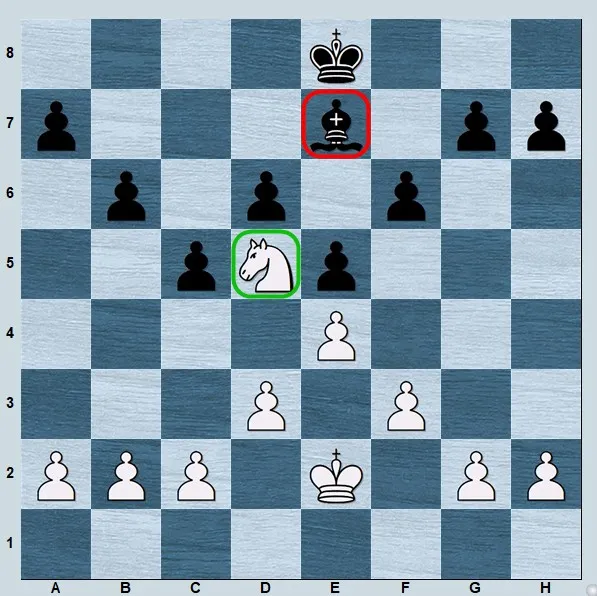The Art of Trading Pieces in Chess
Which pieces do we need to trade and which ones to keep? Follow the tips GM Gabuzyan shares related to exchanges in this article.
Which pieces do we need to trade and which ones to keep? Follow the tips GM Gabuzyan shares related to exchanges in this article.

- Hello, I would like to buy a bottle of water.
- Sure, 500$.
- Ok, I agree.
Before reading the text below, just try to understand how it can be related to chess.
It sounds really crazy to pay 500$ for a bottle of water, but in a chess game, people are often doing the same and don't even feel it.
Let me illustrate it with a simple example.

White has a super-strong Knight on d5, and Black has a very bad dark square Bishop, limited with his Pawns, which are also on dark squares. Now, if you change the d5 Knight with the opponent’s Bishop on e7, it would be like buying a bottle of water for $500 🙂
One of the biggest questions in chess is the following:
Which pieces do we need to trade-off and which ones to keep?
How to answer this question? It's very simple.
Try to understand the price of each piece.
Just take a look at your position. Let's say you have such a strong Knight on d5. As in the example above, you can clearly be sure it's a very strong and expensive piece. Well, it will never be worth as much as a Queen, but sometimes it can be more expensive than a Rook.
Let’s take a look at this example.

White is missing an exchange, but Knight on e4 is just insane. From the center, this piece controls too many squares, and it has several outposts like f6 and d6, while Black Rooks are stuck on 8th rank and don’t even have open files to be activated!
The system in chess works like this: We want to take more and give less.
While it’s shameful to be a person like this in a real-life, during the chess game, it’s a must to be egoistic😅
Let's say we have a piece that we evaluate 50$, and the opponent has one that is 250$, so it will be a fantastic trade.
Sometimes we may have a piece that is equal to the strength of the opponent’s one. However, the opponent’s piece has more potential.
Here is an example:

We have a Bishop on f3, not a bad one, but also not a wonderful one. It is partially limited because of Pawns on d3 and c4. The opponent has a Knight on c6. If it goes to d4, it will become a wonderful piece controlling many important squares and being placed in an amazing position. So obviously, the best choice will be to play Bc6 and trade this Knight.
Now you will probably have a question, how to evaluate pieces. I have good news – It's simple – Pieces are being evaluated by the functions in a particular position.
We should always think, what function is our particular piece.
Let’s look at this example.

You can easily see the difference between White and Black Rooks. While White ones control an open “e” file and are ready to attack Pawns on 7th rank, Black Rooks are too passive and dream about being exchanged.
What about Bishops?
For Bishops, diagonals or strong outposts are like oxygen.
Look at this example:

White Bishop on d5 is just a monster controlling all the board. Bishop on e7 is just jealous of his competitor 🙂
What about Knight?
For Knights, we need strong outposts or good central squares.
Just look at this Knight on d5.

It is placed very well in the center, controlling many squares and blocking isolated Pawn, while White Bishop is just very passive and limited by their pawns.
Would you change the Knight with the opponent’s Bishop?🤔
Understanding when to exchange pieces and which ones — it’s a must-learn skill. Because in almost every chess game, you'll have to make such decisions. There are 3 different ways to improve.
1. Watch the Wolf of the Chess Street: Mastering the Art of Piece Trading course to build a deep understanding.

Before creating, our team spent months researching the material and condensing the knowledge. I had to do multiple revisions to keep the course as detailed and crisp as possible. But the result is fully worth it!❤️
Especially when you see so many students share their reviews on how much they learned from the course.
Many of our students have benefitted a lot as you can see from the course reviews. And with a ChessMood membership, you'll have full access to it.
2. Analyze games of strong grandmasters.
Better if it’s commented with another Grandmaster or a good chess coach.
3. Analyze your games with someone experienced.
Whenever you had positions, when you didn’t know whether it’s right to exchange those pieces or not, collect these positions in one place and then ask your coach or your more experienced friend.
P.S. Don't forget to share your thoughts about this article in our forum.
Originally published Apr 20, 2020

